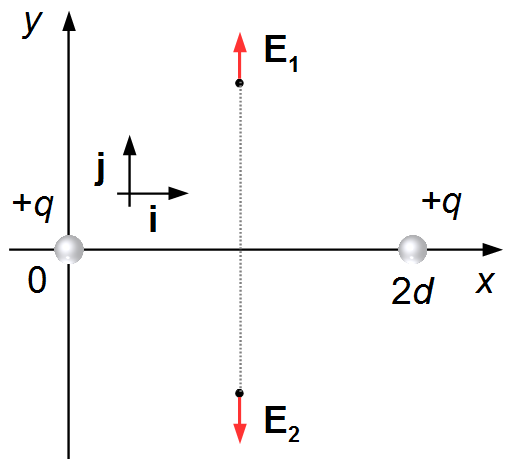Solved Problem on Coulomb's Law and Electric Field
advertisement
Two identical charges of the same sign are separated by a distance of 2d. The magnitude of the electric field at the points along the perpendicular bisector of the line joining the two charges is given by
\[
\begin{gather}
E=\frac{1}{4\pi \epsilon_0}\frac{2qy}{\left(a^2+y^2\right)^{3/2}}
\end{gather}
\]
Determine:
a) The points along the y-axis, for which the magnitude of the electric field assumes its maximum value;
b) The magnitude of the maximum electric field.
Solution
a) To find the maximum value of the electric field, we differentiate the function of the electric field with respect to y, E(y), and equate it to zero
\[
\begin{gather}
\frac{dE}{dy}=0
\end{gather}
\]
Differentiation of \( \displaystyle E(y)=\frac{1}{4\pi \epsilon_0}\frac{2qy}{\left(a^2+y^2\right)^{3/2}} \)
The function E(y) is the quotient of two functions, using the quotient rule
The function E(y) is the quotient of two functions, using the quotient rule
\[
\begin{gather}
\left(\frac{u}{v}\right)^{'}=\frac{u'v-uv'}{v^2}
\end{gather}
\]
where
\( u(y)=y \)
and
\( v(y)=\frac{1}{\left(a^2+y^2\right)^{3/2}} \)
\[
\begin{gather}
\frac{dE}{dy}=\frac{2q}{4\pi \epsilon_0}\frac{\dfrac{d(y)}{dy}\left(a^2+y^2\right)^{3/2}-(y)\dfrac{d\left[\left(a^2+y^2\right)^{3/2}\right]}{dy}}{\left[\left(a^2+y^2\right)^{3/2}\right]^2}
\end{gather}
\]
the function v(y) is a composite function, using the Chain Rule
\[
\begin{gather}
\frac{dv[w(y)]}{dy}=\frac{dv}{dw}\frac{dw}{dy}
\end{gather}
\]
where
\( v(w)=w^{3/2} \)
and
\( w(y)=a^2+y^2 \)
\[
\begin{gather}
\frac{dE}{dy}=\frac{2q}{4\pi\epsilon_0}\frac{1\times\left(a^2+y^2\right)^{3/2}-y\left[\dfrac{d\left(w^{3/2}\right)}{dg}\dfrac{d\left(a^2+y^2\right)}{dy}\right]}{\left(a^2+y^2\right)^3}\\[5pt]
\frac{dE}{dy}=\frac{2q}{4\pi\epsilon_0}\frac{\left(a^2+y^2\right)^{3/2}-y\left[\left(\dfrac{3}{\cancel 2}w^{\frac{3}{\cancel 2}-1}\right)(\cancel 2 y)\right]}{\left(a^2+y^2\right)^3}\\[5pt]
\frac{dE}{dy}=\frac{2q}{4\pi\epsilon_0}\frac{\left(a^2+y^2\right)^{3/2}-3\left(a^2+y^2\right)^{1/2}y^2}{\left(a^2+y^2\right)^3}\\[5pt]
\frac{dE}{dy}=\frac{2q}{4\pi\epsilon_0}\left[\frac{\left(a^2+y^2\right)^{3/2}}{\left(a^2+y^2\right)^3}-\frac{3\left(a^2+y^2\right)^{1/2}y^2}{\left(a^2+y^2\right)^3}\right]\\[5pt]
\frac{dE}{dy}=\frac{2q}{4\pi\epsilon_0}\left[\frac{1}{\left(a^2+y^2\right)^3\left(a^2+y^2\right)^{-3/2}}-\frac{3y^2}{\left(a^2+y^2\right)^3\left(a^2+y^2\right)^{-1/2}}\right]\\[5pt]
\frac{dE}{dy}=\frac{2q}{4\pi\epsilon_0}\left[\frac{1}{\left(a^2+y^2\right)^{3/2}}-\frac{3y^2}{\left(a^2+y^2\right)^{5/2}}\right]
\end{gather}
\]
Letting the derivative to zero
\[
\begin{gather}
\frac{2q}{4\pi\epsilon_0}\left[\frac{1}{\left(a^2+y^2\right)^{3/2}}-\frac{3y^2}{\left(a^2+y^2\right)^{5/2}}\right]=0\\[5pt]
\frac{1}{\left(a^2+y^2\right)^{3/2}}=\frac{3y^2}{\left(a^2+y^2\right)^{5/2}}\\[5pt]
\frac{\left(a^2+y^2\right)^{5/2}}{\left(a^2+y^2\right)^{3/2}}=3y^2\\[5pt]
\left(a^2+y^2\right)^{5/2}\left(a^2+y^2\right)^{-3/2}=3y^2\\[5pt]
\left(a^2+y^2\right)^{\frac{5}{2}-\frac{3}{2}}=3y^2\\[5pt]
\left(a^2+y^2\right)^{\frac{2}{2}}=3y^2\\[5pt]
a^2+y^2=3y^2\\[5pt]
3y^2-y^2=a^2\\[5pt]
y^2=\frac{a^2}{2}\\[5pt]
y=\sqrt{\frac{a^2}{2}}\\[5pt]
y=\pm{\frac{a}{\sqrt 2}\times\frac{\sqrt 2}{\sqrt{2}}}
\end{gather}
\]
\[
\begin{gather}
\bbox[#FFCCCC,10px]
{y=\frac{a\sqrt{2}}{2}}
\end{gather}
\]
\[
\begin{gather}
\bbox[#FFCCCC,10px]
{y=-{\frac{a\sqrt{2}}{2}}}
\end{gather}
\]
b) Substituting the values of y found in item (a) in the expression given in the problem
\[
\begin{gather}
E\left(\small{\frac{a\sqrt 2}{2}}\right)=\frac{1}{4\pi\epsilon_0}\frac{2q\dfrac{a\sqrt 2}{2}}{\left[a^2+\left(\dfrac{a\sqrt 2}{2}\right)^2\right]^{3/2}}\\[5pt]
E\left(\small{\frac{a\sqrt 2}{2}}\right)=\frac{1}{4\pi\epsilon_0}\frac{2q}{\left[a^2+\dfrac{a^2}{2}\right]^{3/2}}\frac{a\sqrt 2}{2}\\[5pt]
E\left(\small{\frac{a\sqrt 2}{2}}\right)=\frac{1}{4\pi\epsilon_0}\frac{2q}{\left[\dfrac{2a^2+a^2}{2}\right]^{3/2}}\frac{a\sqrt 2}{2}\\[5pt]
E\left(\small{\frac{a\sqrt 2}{2}}\right)=\frac{1}{4\pi\epsilon_0}\frac{2q}{\left[\dfrac{3a^2}{2}\right]^{3/2}}\frac{a\sqrt 2}{2}\\[5pt]
E\left(\small{\frac{a\sqrt 2}{2}}\right)=\frac{1}{4\pi\epsilon_0}\frac{2q}{\dfrac{3a^2}{2}\left[\dfrac{3a^2}{2}\right]^{1/2}}\frac{a\sqrt 2}{2}\\[5pt]
E\left(\small{\frac{a\sqrt 2}{2}}\right)=\frac{1}{4\pi\epsilon_0}\frac{2q}{\dfrac{3a^2}{\cancel 2}\dfrac{\cancel a\sqrt 3}{\sqrt 2}}\frac{\cancel a\sqrt 2}{\cancel 2}\\[5pt]
E\left(\small{\frac{a\sqrt 2}{2}}\right)=\frac{1}{4\pi\epsilon_0}\frac{2q}{3a^2\sqrt 3}\sqrt 2\times\sqrt 2
\end{gather}
\]
\[
\begin{gather}
\bbox[#FFCCCC,10px]
{E=\frac{1}{4\pi \epsilon _0}\frac{4q}{3\sqrt 3 a^2}}
\end{gather}
\]
Note: The calculation made with the value
\( y=-{\frac{a\sqrt{2}}{2}} \)
gives the result
\[
\begin{gather}
E=-{\frac{1}{4\pi\epsilon_0}}\frac{4q}{3\sqrt 3 a^2}
\end{gather}
\]
the minus sign indicates that the electric field vector is pointing in the opposite direction to the
unit vector j (Figure 1).

advertisement

Fisicaexe - Physics Solved Problems by Elcio Brandani Mondadori is licensed under a Creative Commons Attribution-NonCommercial-ShareAlike 4.0 International License .